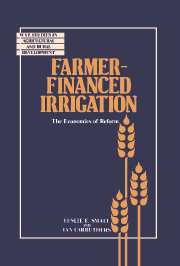Book contents
- Frontmatter
- Contents
- Preface
- 1 Irrigation financing in perspective
- Part I Analysing financing policies: theory and concepts
- Part II Criteria for evaluating irrigation financing policies
- Part III Financial autonomy and user fees: key implementation issues
- 9 Establishing financial autonomy
- 10 Setting irrigation fees: reconciling the need for funds with farmers' ability to pay
- 11 Collecting irrigation fees: fostering a willingness to pay
- 12 The political economy of irrigation financing
- 13 Conclusions and recommendations
- Notes
- Index
9 - Establishing financial autonomy
Published online by Cambridge University Press: 05 November 2011
- Frontmatter
- Contents
- Preface
- 1 Irrigation financing in perspective
- Part I Analysing financing policies: theory and concepts
- Part II Criteria for evaluating irrigation financing policies
- Part III Financial autonomy and user fees: key implementation issues
- 9 Establishing financial autonomy
- 10 Setting irrigation fees: reconciling the need for funds with farmers' ability to pay
- 11 Collecting irrigation fees: fostering a willingness to pay
- 12 The political economy of irrigation financing
- 13 Conclusions and recommendations
- Notes
- Index
Summary
Implementation of irrigation financing policies must begin with decisions on how funds are to be generated. Are all funds to come from the government? Are users expected to provide a portion of the funds? If so, on what basis are they to be asked to pay? Are there other sources of funds that may be made available to help pay for irrigation services? These questions deal with the overall structure of irrigation financing.
In situations of central financing, the structure of financing is generally very simple: all funds come from the government, although in some cases more than one level of government may be involved. Important implementation questions exist regarding the amount of funding (dealt with in Chapter 10), but not with regard to the sources of funding.
Under financial autonomy, however, the structure of funding is more complex. Although a significant portion of an irrigation agency's revenues must come from user fees, frequently government subsidies comprise another important source of revenue. This reflects the fact that financial autonomy does not necessarily mean complete financial self-sufficiency. A third common source of funds under financial autonomy is secondary income derived either from the sale or rental of assets owned by the irrigation agency, or from special services that it renders.
In this chapter we first examine each of these three sources of financing the costs of irrigation under financial autonomy.
- Type
- Chapter
- Information
- Farmer-Financed IrrigationThe Economics of Reform, pp. 139 - 159Publisher: Cambridge University PressPrint publication year: 1991



